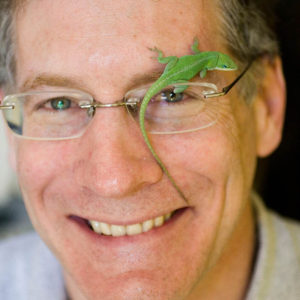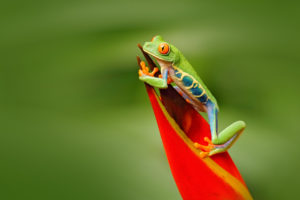In less than half a century, global populations of fish, birds, mammals, amphibians and reptiles have declined to less than half their size. One in five of the plant species on earth is currently threatened with extinction in the wild, putting supplies of food and medicines at risk. And some scientists believe a sixth mass extinction event is underway on Earth, triggering the largest loss of species since an asteroid slammed into the planet 66 million years ago, wiping out the dinosaurs and many other species.
If the statistics sound dire, that’s because they are. The situation is urgent and scientists say there’s no time to lose if they are going to try to reverse the cycle of loss and save Earth’s remaining species.
With this imperative in mind, internationally renowned biologist Jonathan Losos is coming from Harvard University to Washington University in St. Louis to lead the newly created Living Earth CollaborativeTM. In establishing the collaborative, the university is joining forces with two of the nation’s leading institutions in the study and preservation of plants and animals — the Missouri Botanical Garden and the Saint Louis Zoo — to create a new academic center dedicated to advancing the study of biodiversity to help ensure the future of Earth’s species in their many forms.
“The plight of our planet’s species is quite literally a matter of life and death,” said Chancellor Mark S. Wrighton. “It is incumbent on research institutions like ours to step up and find ways to undo the damage that has already been done and work toward solutions to preserve against future loss. By bringing together these three world-class entities, the Living Earth CollaborativeTM will harness the power of some of the top minds in the field of biodiversity to tackle our biggest global challenges, and place St. Louis at the forefront of this critical research endeavor.”

Beginning in January, the Living Earth CollaborativeTM will be headquartered at Washington University under the direction of Losos, who will rejoin the Arts & Sciences faculty at Washington University in the new year as the inaugural holder of the William H. Danforth Distinguished University Professorship, established last year by the university in honor of Danforth, the former chancellor, on the occasion of his 90th birthday. An internationally renowned scholar in the field of evolutionary biology, Losos is returning to Washington University, where he has deep roots and a long history, including as a member of the faculty from 1992-2006. He currently serves as the Lehner Professor for the Study of Latin America, professor of organismic and evolutionary biology, and curator in herpetology at the Museum of Comparative Zoology at Harvard University. His study of the behavioral and evolutionary ecology of lizards has taken him around the globe and firmly established his position as a leading international expert on the biodiversity of species.
Losos will be a prominent addition to an already strong cadre of biodiversity scientists in biology, anthropology and other fields across Washington University, which long has been recognized as a leader in the field, with honors including a No. 1 ranking alongside Princeton University in the National Research Council’s 2009 survey of doctoral programs in ecology and evolutionary biology.
“To have one of the most highly regarded researchers in the field of biodiversity joining the Washington University faculty is cause for great celebration,” said Barbara Schaal, dean of the faculty of Arts & Sciences and the Mary-Dell Chilton Distinguished Professor at Washington University. “Jonathan Losos has dedicated his life and career to the study of living creatures, and we all should be grateful for his passion for preserving the world’s species and creating a better place for all of us to live. We are delighted to welcome him to Washington University.”
“The opportunity to join the already fabulous group of biodiversity researchers at Washington University, and to partner with St. Louis’ internationally recognized zoo and botanical garden was simply too good to pass up,” Losos said. “As a native St. Louisan, I am delighted to return to where my love of nature and science first blossomed, and where the important work of furthering our knowledge of biodiversity and preservation has always been a priority. With the creation of the Living Earth CollaborativeTM, three leading institutions will join forces, wedding their complementary expertise and approaches, to establish a collaboration with few parallels in the country or the world.
“The potential for growth and synergy beyond the initial launch of the collaborative is unlimited. In addition to our core partners, St. Louis also is home to a number of other prominent research organizations, including, notably, the Whitney R. Harris World Ecology Center at the University of Missouri-St. Louis. We look forward to working with other local institutions to make St. Louis a global leader in biodiversity research and conservation.”

The Living Earth CollaborativeTM will serve as a hub to facilitate interdisciplinary research among plant and animal biologists and other scholars across a wide range of fields, bringing together the world’s leading scholars in the field of biodiversity to address the most pressing issue facing humankind today — the ability to sustain life on Earth. With their decades of work in the field of biodiversity, the Missouri Botanical Garden and Saint Louis Zoo bring robust resources to the partnership, including vast collections of living organisms; research centers such as the Zoo’s Institute for Conservation Medicine, which focuses on wildlife, public health and sustainable ecosystems; and world-renowned experts at both institutions, including some 50 PhD-level researchers at the garden. In coming together, the Living Earth CollaborativeTM will be a powerful force in the global effort to understand our living world and to discover how humans can help preserve the varied natural environments that allow plants, animals and microbes to survive and thrive.
“Biodiversity conservation and research is fundamental to all we do at the Missouri Botanical Garden, so we are very pleased to be a part of this new Living Earth CollaborativeTM,” said Peter Wyse Jackson, president of the Missouri Botanical Garden. “Through our active participation in this new center, we look forward to developing new synergies between our extensive research teams at the garden and those at Washington University and the Saint Louis Zoo. Effective biodiversity conservation needs to be based on excellent cross-disciplinary science, so this initiative is both greatly welcomed and urgently required.”
“The Saint Louis Zoo and our WildCare Institute, the Zoo’s conservation arm, have a deep history of working with Washington University in St. Louis and the Missouri Botanical Garden. I look forward to this expanded partnership through the Living Earth CollaborativeTM,” said Jeffrey P. Bonner, the Dana Brown President and CEO of the Saint Louis Zoo. “Together, with our experts in such areas as reproductive and behavioral sciences, animal nutrition, biology, veterinary epidemiology, endocrinology, conservation sciences and wildlife management, I know we can help create a sustainable future for wildlife and for people around the world.”
About Washington University
Washington University in St. Louis is counted among the world’s leaders in teaching and research, and it draws students and faculty to St. Louis from all 50 states and more than 100 nations. The total student body is more than 14,000 undergraduate, graduate and professional students.
The approximately 3,400 faculty teach in seven schools: Arts & Sciences, Brown School, Olin Business School, Sam Fox School of Design & Visual Arts, School of Engineering & Applied Science, School of Law and School of Medicine. Twenty-four Nobel laureates have been associated with Washington University, with nine doing the major portion of their pioneering research there.
The university offers more than 90 programs and almost 1,500 courses leading to bachelor’s, master’s and doctoral degrees in a broad spectrum of traditional and interdisciplinary fields, with additional opportunities for minor concentrations and individualized programs.
About the Missouri Botanical Garden
The Missouri Botanical Garden’s mission is “to discover and share knowledge about plants and their environment in order to preserve and enrich life.” Today, 158 years after opening, the Missouri Botanical Garden is a National Historic Landmark and a center for science, conservation, education and horticultural display. The Missouri Botanical Garden focuses its work on areas that are rich in biodiversity yet threatened by habitat destruction, and operates the world’s most active research and training programs in tropical botany.
The garden’s Center for Conservation and Sustainable Development exists to safeguard the Earth’s biodiversity through the collaborative development and application of scientific expertise and resources. The William L. Brown Center is dedicated to the study of useful plants; understanding the relationships between humans, plants and their environment; the conservation of plant species; and the preservation of traditional knowledge for the benefit of future generations. The herbarium of the Missouri Botanical Garden has over 7 million specimens, making it one of the largest in the world, and the garden’s collections include over 17,000 plant species and varieties, many that are rare or endangered in the wild. Garden scientists collaborate with governments, local institutions, schools and indigenous people to understand plants, raise awareness, and offer alternatives and craft conservation strategies. The Missouri Botanical Garden is striving for a world that can sustain us without sacrificing prosperity for future generations, a world where people share a commitment to managing biological diversity for the common benefit.
About the Saint Louis Zoo
Chosen as America’s top free attraction and best zoo in USA Today’s 10 Best Readers’ Choice Awards, the Saint Louis Zoo is widely recognized for its innovative approaches to animal care and management, wildlife conservation, research and education. One of the few free zoos in the nation, the zoo attracts more than 3,000,000 visitors a year. For more information, visit stlzoo.org, Saint Louis Zoo WildCare Institute and Institute for Conservation Medicine.